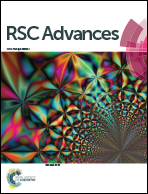Cation–π interaction in cofacial molecular dyads: a DFT and TDDFT study†
Abstract
In this study we proposed a cofacial molecular dyad or a tweezer (4,5-biphenyl acridine, BPA) with the acridine moiety serving as the spacer and two phenyl rings as the wings. Density functional theory (DFT) calculation was implemented to illustrate the pivotal role of the phenyl rings in stabilizing the cation (Li+, Na+ or K+) at the tweezers via cation–π interaction. Our calculations reveal that apart from the covalent interaction, the cation–π interaction energy contributes to the stabilization of cations inside the molecular pocket. The effect of substituents on the structure and interaction energy of the cation–π complexes was also exemplified. An electron donating group favored the cation–π interaction while an electron withdrawing group lowered the strength of cation–π interaction. Solvent polarity was found to play a critical role in stabilizing the cation–π interaction. Solvents with a low dielectric constant mostly favored such interaction while highly polar solvents resulted in repulsive interaction energy. TDDFT (time dependent density functional theory) calculations were performed to understand the effect of the cation–π interaction on the absorption spectra of such molecular dyads.


 Please wait while we load your content...
Please wait while we load your content...